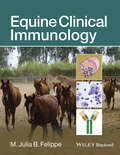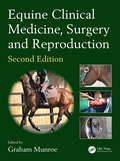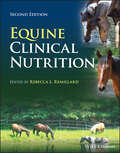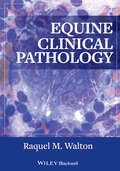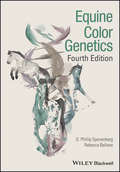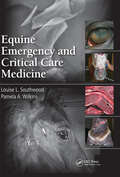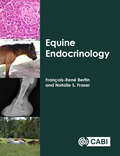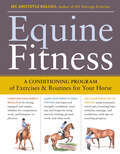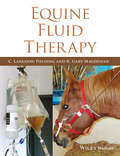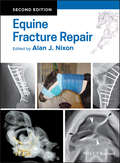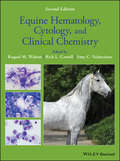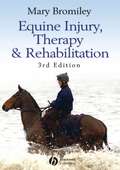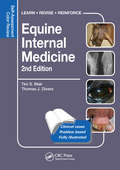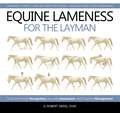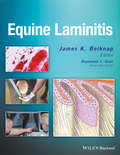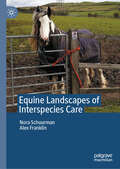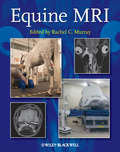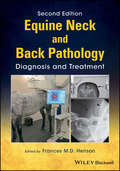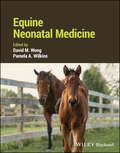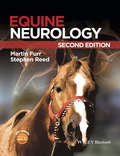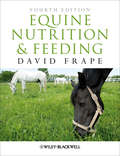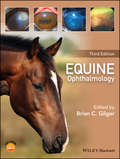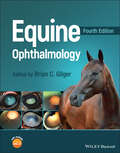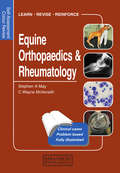- Table View
- List View
Equine Clinical Immunology
by M. Julia FelippeEquine Clinical Immunology offers comprehensive information on equine immunological disorders.* Provides a complete, equine-specific reference on clinical immunology * Focuses on clinically relevant information for the diagnosis and treatment of horses with immune disorders * Illustrates the concepts discussed using drawings, photographs, and tables * Presents key concepts, clinical assessment information, and treatment approaches in text boxes for ease of use * Offers a practical, clinically oriented approach ideal for equine specialists
Equine Clinical Medicine, Surgery and Reproduction, Second Edition (Manson Ser.)
by Graham MunroeThis fully-revised new edition of the bestselling Equine Clinical Medicine, Surgery and Reproduction is supported by over 1800 illustrations of the highest quality: colour photographs, radiographic and ultrasound images, and diagrams. System-based, the chapters introduce each individual system with precise information on the relevant basic anatomy and physiology, standard clinical examination techniques and useful differential diagnostic aids. This is followed by diseases and disorders that are pertinent to that system, grouped together either anatomically or based on presenting clinical signs. Each condition is described using consistent headings: definition/overview, etiology and pathophysiology, clinical presentation, diagnosis, differential diagnoses, management/treatment, and prognosis. Additional chapters deal with the foal, with wounds and behavioural problems. New to the second edition is expanded material on the musculoskeletal system, a new muscle section, updated information on reproduction, including assisted breeding and laparoscopic techniques, more information on diagnostic tests including over ground endoscopy, chest ultrasonography and head CT, and a significantly expanded surgical section. The material on equine dentistry, neurology, endocrine system and the liver has also been considerably developed. The focus throughout remains on providing clinically relevant information required for practical case management, plus sufficient background on causes and disease processes to enable readers to understand the conditions and the rationale for diagnostic and treatment options. Expert authors come together under the editorship of Dr Graham Munroe to create a textbook that will be of lasting value as a teaching and training resource for equine specialists and students in veterinary medicine and related equine courses, as well as a ready reference for non-specialist practitioners.
Equine Clinical Nutrition
by Rebecca L. RemillardEQUINE CLINICAL NUTRITION Authoritative resource on the nutritional management of horses, now incorporating the iterative learning process The second edition of Equine Clinical Nutrition is a fully updated and expanded revision of the classic student text on nutritional management of horses, covering updated nutrient recommendations, rations, feeding management, clinical nutrition and many other important topics in the field. To aid in reader comprehension, this new edition takes a new instructional approach to nutritional management using an iterative sequence of defined procedures. Divided into distinct sections for easy accessibility, this book is a comprehensive resource for feeding practices and management of healthy and sick horses alike. A thorough understanding of life stages, anatomy, physiology, and behavior underpins the practice of clinical nutrition. Sample topics covered in Equine Clinical Nutrition include: The evolution of horses to changing food supply, the importance of their microbiome, and the behavior patterns of feeding and drinking Nutrient metabolism of water, energy, protein, minerals, and vitamins, plus ration assessment, farm investigations, forages, and toxic plants Manufactured feeds, dietary supplements, USA feed regulations, and feed safety protocols Nutritional assessment of horses by life stage, recognizing pain and discomfort behaviors, and dietary management of weight and major system disorders Equine Clinical Nutrition is an essential text for students of veterinary medicine, animal science, pre-veterinary programs, and a desk reference for equine practitioners wanting practical clinical feeding recommendations. With comprehensive coverage of the topic, it is an essential text for everything related to nutrition in horses.
Equine Clinical Pathology
by Raquel M. WaltonEquine Clinical Pathology is the first complete resource for hematology and clinical chemistry in horses. Encompassing the basic principles and advanced interpretation, the book's single-species approach to pathology allows for focused coverage of the unique disease characteristics of equids. Equine Clinical Pathology is equally useful for anyone using clinical pathology as a diagnostic tool, from beginning student to experienced specialist.The heart of the book is organized by body system, making it easy to find and apply information. Chapters cover general laboratory medicine, including instruments and techniques, hematology, and proteins as well as specific organs, such as the kidney and liver. Equine Clinical Pathology is a useful bench-side reference for anyone involved in laboratory medicine for the horse.
Equine Color Genetics
by D. Phillip Sponenberg Rebecca BelloneEquine Color Genetics, Fourth Edition presents a detailed examination of the color variation in horses and donkeys and the genetic mechanisms that produce color variations. Thoroughly covers the basic colors in horses, including bay, chestnut, black, and brown Details the genetic basis of the colors built from the basic coat color, including dilutions and white patterning Provides an explanation of genetic mechanisms that determine coat color Presents a thorough revision and update, including new advances in molecular genetics, biochemistry, molecular mechanisms, genetic loci, coat colors before domestication, and more Offers a new introduction describing the principles of genetics and genomics research to help outline how knowledge is discovered and to assist the reader in understanding concepts covered in the book
Equine Emergency and Critical Care Medicine
by Louise L. Southwood Pamela A. WilkinsEarly recognition of problems by owners, appropriate first aid, and timely referral by field veterinarians improve the chance of survival for horses requiring emergency management and critical care. With a view toward improving patient outcome, Equine Emergency and Critical Care Medicine is written by a team of enthusiastic equine specialists who e
Equine Endocrinology
by François-René Bertin Natalie S FraserThis book provides a practical, clinical approach to diagnosing, treating, and managing endocrine diseases in the horse. Each chapter uses the same structure to form a user-friendly tool of information and advice on aetiology, pathophysiology, clinical presentation, diagnosis and treatment for each endocrine disorder. This book covers: - approaches to endocrine disorders; - diseases of the hypothalamo-pituitary-thyroid axis; - disorders in calcium regulation and diseases of the parathyroid gland; - diseases of the hypothalamo-pituitary-adrenocortical axes; - diseases of the endocrine pancreas and Equine Metabolic Syndrome; - hyperlipaemia and lipid metabolism disorders; and - endocrine disorders associated with the female and male reproductive systems. This book also includes material on additional endocrinopathies, such as diabetes insipidus and pheochromocytoma, and is dedicated to the fast-moving field of equine endocrinology. Written by world-leading international experts, it collates their insights and experience into approaches that prove invaluable for general equine practitioners.
Equine Exercise Physiology
by David Marlin Kathryn J. NankervisEquine exercise physiology is an area that has been subject to major scientific advances over the last 30 years, largely due to the increased availability of high-speed treadmills and techniques for recording physiological function during exercise. Despite the scientific advances, many riders and trainers are still using little more than experience and intuition to train their horses. The aim of this book is to sort the fact from the fiction for the benefit of those involved in training, managing or working with horses, and to provide an up-to-date summary of the state of play in equine exercise physiology. Scientific theories are explained from first principles, with the assumption that the reader has no previous scientific background. The book is designed to save competitors and trainers a lot of time and effort trying to extract information in piecemeal fashion from a host of reference sources. For the first time, everything you need to know about exercising and training horses is here in one text.
Equine Fitness: A Program of Exercises and Routines for Your Horse
by Jec Aristotle BallouGet your horse in shape and maintain his overall fitness, regardless of his age or abilities. Equine Fitness will have your horse looking and feeling his best with a series of fun exercise routines specifically designed to enhance his strength, stamina, and agility. Clear step-by-step instructions and detailed illustrations make the exercises easy to follow, and the book includes a handy set of pocket-sized cards that you can use in the ring. Jec Ballou&’s simple conditioning program promises lasting results for healthy horses and satisfied riders.
Equine Fluid Therapy
by K. Gary Magdesian C. Langdon FieldingEquine Fluid Therapy is the first reference to draw equine-specific fluid therapy information together into a single, comprehensive resource. Offering current information unique to horses on the research and practice of fluid, electrolyte, and acid-base disorders, the book is designed to be clinically oriented yet thorough, providing detailed strategies tailored to equine practice. With information ranging from physiology and acid-base balance to fluid therapy for specific conditions, Equine Fluid Therapy covers fluid treatments in both adult horses and foals, highlighting the unique physiologic features, conditions, and differences in foals.Well-illustrated throughout, the book begins with an overview of the physiology of fluids, electrolytes, and acid-base, then moves into practical information including equipment, monitoring techniques, fluid choices, and potential complications. A final section offers chapters on blood transfusions, colloids, parenteral nutrition, and hemodynamic monitoring. Equine Fluid Therapy is an essential reference for equine practitioners, specialists, and researchers.
Equine Fracture Repair
by Alan J. NixonOffers a long-awaited Second Edition of this comprehensive, state-of-the-art reference for fracture repair in horses The Second Edition of Equine Fracture Repair has been thoroughly revised and updated to present the most current information on fracture repair in horses. Written to be accessible, the text is logically arranged, presenting the most authoritative information on equine fracture repair with explanations of the expected outcomes. The book provides valuable insight as to whether a fracture should be repaired, the degree of difficulty of the procedure, and a wealth of practical information on surgical techniques. This fully revised Second Edition offers a valuable tool for veterinarians making clinical decisions when faced with horse fractures, covering emergency care and splinting, the most current innovative techniques in equine fracture repair, and new implant systems. With contributions from leading experts in the field, the revised edition continues to be the essential reference to the subject. This essential resource: Offers a revised edition of the most comprehensive reference on the repair of fracture in horses, with complete information on patient assessment, emergency splinting and casting, and guidance in treatment choices Includes contributions from leading experts in the field Presents information organized by fracture type for quick access Provides valuable outcome assessment with helpful discussions of the degree of difficulty to aid in case management, incorporating information on the newest techniques and implant systems Concludes with extensive information on the identification and management of complications associated with fractures and repair methods This revised and updated edition of Equine Fracture Repair continues to provide a comprehensive resource for understanding the most effective and current techniques available for the treatment of fractures in horses.
Equine Hematology, Cytology, and Clinical Chemistry
by Raquel M. Walton Rick L. Cowell Amy C. ValencianoThe all-new Equine Hematology, Cytology, and Clinical Chemistry draws on hematology and clinical chemistry information featured in the first edition of Equine Clinical Pathology and adds valuable cytopathology material from Diagnostic Cytology and Hematology of the Horse, making it a truly definitive reference to clinical pathology in equids. Thoroughly updated and expanded throughout, this Second Edition offers more images, more information, and new knowledge for previous chapters and entirely new chapters on bone marrow evaluation and cytopathology. Designed to present clear, concise, and clinically relevant information, the book is logically organized for easy reference. Numerous figures, tables and images support the text, together with summarized information for ease of use. Offers a focus on clinical pathology in the horse, with in-depth information on hematology, clinical chemistry, and cytopathology in equids Presents equine disease from a systems-based, clinicopathological perspective Features hundreds of high-quality images Includes contributions from veterinary specialists with expert knowledge of clinical pathology A must-have purchase for anyone using hematology, clinical chemistry, and cytology in equine patients, Equine Hematology, Cytology, and Clinical Chemistry, 2nd Edition is a valuable resource for equine practitioners, clinical pathologists and residents, and veterinary students.
Equine Injury, Therapy and Rehabilitation
by Mary BromileyMary Bromiley’s book remains essential reading for both professionals and the general riding community. This new edition builds on the huge success of the previous editions, first published in 1987. Fully updated to reflect recent technological advances in diagnostic ability, as well as the proven physiological effects of light, magnetic fields and electrical currents on body tissues. This information allows readers to both understand and make an informed choice of appropriate therapy following a diagnosed injury. The original edition was the first book on the subject and it has continued to be a bestseller. Covers a subject that is of worldwide interest. The author is recognised as a pioneer at the forefront of this type of treatment.
Equine Internal Medicine: Self-Assessment Color Review Second Edition (Veterinary Self-Assessment Color Review Series)
by Tim S. Mair Thomas J. DiversWritten by well-respected experts from the UK and USA, Equine Internal Medicine: Self-Assessment Color Review Second Edition presents more than 200 interesting and challenging cases encountered in equine practice, complete with photographs, imaging, or endoscopy findings; blood or fluid smears; other ancillary tests; and, in some cases, pathologic
Equine Lameness for the Layman
by G. Robert GriselLameness is the most common cause of poor performance in the horse. This makes management of his soundness over the long–term integral to both his general well–being and his ability to participate in recreational and competitive activities.Unfortunately, most equine caretakers are unable to perceive abnormal movement in the horse, extending the period between the onset of a problem and its eventual treatment, and the longer an issue is allowed to persist, the greater the chance that it will progress. Many equine veterinarians also find it difficult to visually decipher lameness, which leads to lengthy, expensive, and often inaccurate diagnostic work–ups. It is with these two key audiences in mind that Dr. Bob Grisel has created a book unlike any other. With hundreds of illustrations, dozens of charts, and links to online videos of explanatory case studies, readers are given a complete course in observing, identifying, and decoding equine lameness. Dr. Grisel helps you interpret what is seen, plain and simple (no need for medical knowledge of equine anatomy and pathology). Whether first–time horse owner or seasoned professional, you are guaranteed to come away with a detailed, systematic, and comprehensive method for a happier, healthier equine partner.
Equine Laminitis
by James K. Belknap Raymond J. GeorThe first book dedicated to this common, serious, and complex equine disease, Equine Laminitis is the gold-standard reference to the latest information on every aspect of the disease and its treatment. Provides the first book devoted specifically to equine laminitis Discusses the current state of knowledge on all aspects of the disease, including its history, relevant anatomical considerations, pathophysiology, the diagnostic workup, and clinical treatment Presents 50 chapters written by leading international experts, under the editorship of the foremost authority on equine laminitis Offers a thorough understanding of this common affliction, grounded in the scientific literature Describes effective prevention and treatment plans
Equine Landscapes of Interspecies Care
by Nora Schuurman Alex FranklinThis book focuses on the spaces and practices of caring for horses, explored in a series of case studies set across the equine lifespan. For horses, everyday practices of care as well as ever-changing understandings of what is good care directly shape their living conditions and lives with humans. In this book, questions of animal ethics and welfare are approached in a tangible way by exploring the relationships and practices of interspecies care across a range of different spaces, including horse yards, training grounds, farms, rescue centres and the street. The chapters illuminate the ways in which interspecies care ties horses to human society and culture, addressing care practices in different stages of the equine life cycle. Through a unique set of case-studies addressing issues such as training, working, rescue, aging and death, the book offers a clear overview of how humans shape the lifespan of animals living under their care. It simultaneously foregrounds the agency of animals in this process and how such agency is interpreted and responded to by humans. With its theoretically solid analysis of rigorous empirical study, the book answers the need to understand human connection to the nonhuman world within the everyday practices and spaces of contemporary society and culture.
Equine MRI
by Rachel C. MurrayEquine MRI is a unique, comprehensive guide to MRI in the horse. Edited by Rachel Murray, a leading authority and researcher in the field with over ten years of equine clinical MRI experience, the book also includes contributions from worldwide experts in the subject. Divided into the following four sections, the book presents key information based on previous validation work and clinical practice: Principles of MRI, including the practicalities of image acquisition and interpretation Normal MRI anatomy and normal variations Different types of pathological change Options for clinical management and prognosis for different conditions MRI is a rapidly expanding area in veterinary medicine that confers detailed, three-dimensional information on both bone and soft tissue. Expanding clinical knowledge, improvements in technology, and practical application of MRI to the standing and recumbent horse means this useful imaging modality has become an integral and essential part of the diagnostic evaluation in lameness and is a realistic option for investigation of ophthalmological, neurological and cranial pathology. Equine MRI enables readers to understand the best ways to achieve good quality images, and provides a detailed explanation of the problems that may occur. With close to 950 normal and abnormal images, this book offers considerable detail and examples of both common and uncommon problems, making it a great reference for equine veterinarians, veterinary students, specialists in equine surgery, and specialists in veterinary imaging.
Equine Neck and Back Pathology: Diagnosis and Treatment
by Frances M. HensonA unique reference dedicated to the diagnosis and treatment of problems of the equine neck and back Building on the strength of the first edition, Equine Neck and Back Pathology: Diagnosis and Treatment, Second Edition explores conditions and problems of the horse's back and pelvis, and has been expanded to include coverage of the neck as well. This book is a vital tool for all those engaged in improving the diagnosis and management of horses with neck or back problems. The only book devoted to the conditions and problems of the equine neck, back and pelvis, it provides comprehensive coverage by international specialists on how to diagnose and treat problems in these areas. This updated and revised edition covers normal anatomy and kinematics, neck and back pathology, diagnosis and treatment of specific conditions, and complementary therapy and rehabilitation. Equine Neck and Back Pathology: Diagnosis and Treatment, Second Edition is a valuable working resource for equine practitioners, specialists in equine surgery, veterinary nurses and allied professionals involved in treating horses. It is also an excellent supplementary text for veterinary students with a keen interest in horses.
Equine Neonatal Medicine
by Pamela A. Wilkins David M. WongEquineNeonatal Medicine A comprehensive guide to medical care for pregnant mares and neonatal foals Equine Neonatal Medicine offers an in-depth comprehensive reference for the clinical management of pregnant and periparturient mares and neonatal foals. Edited by leading experts in the field and written by experienced equine specialists, this textbook covers all aspects of providing veterinary care to mares and neonatal foals. Encompassing physiology, pathophysiology, theory, and practice, this textbook offers an authoritative, well-illustrated reference to equine perinatology. Topics covered include breeding management, pregnancy detection, fetal monitoring, parturition, and peri-parturient disorders in the mare as well as diagnostic and therapeutic options for ill neonatal foals. The book: Covers aspects of veterinary care for the pregnant and peri-parturient mare and how to diagnose and treat the ill neonate Discusses breeding management, pregnancy detection, fetal monitoring and parturition, and peri-parturient disorders in the mare Presents an exhaustive, detailed, and comprehensive reference for any veterinary practitioner involved with breeding management of horses and the care of neonatal foals Provides a clinical perspective, including both theory and practice Features more than 600 color images and diagrams to demonstrate the concepts discussed Equine Neonatal Medicine is an essential reference for any veterinary practitioner engaged with mares and foals, including specialists in equine medicine, equine and mixed animal practitioners, ambulatory practitioners, and veterinary students.
Equine Neurology
by Stephen Reed Martin FurrEquine Neurology, Second Edition provides a fully updated new edition of the only equine-specific neurology book, with comprehensive, clinically oriented information. *Offers a complete clinical reference to neurologic conditions in equine patients *Takes a problem-based approach to present a clinically oriented perspective *Presents new chapters on imaging the nervous system, neuronal physiology, sleep disorders, head shaking, differential diagnosis of muscle trembling and weakness, and cervical articular process joint disease *Covers the basic principles of neurology, clinical topics such as the initial exam, differentials, and neuropathology, and specific conditions and disorders *Includes access to a companion website offering video clips demonstrating presenting signs Equine Neurology, Second Edition provides a fully updated new edition of the only equine-specific neurology book, with comprehensive yet practical information. *Offers a complete clinical reference to neurologic conditions in equine patients *Takes a problem-based approach to present a clinically oriented perspective *Presents new chapters on imaging the nervous system, neuronal physiology, sleep disorders, head shaking, differential diagnosis of muscle trembling and weakness, and cervical articular process joint disease *Covers the basic principles of neurology, clinical topics such as the initial exam, differentials, and neuropathology, and specific conditions and disorders *Includes access to a companion website offering video clips demonstrating presenting signs
Equine Nutrition and Feeding
by David FrapeSince the first edition of Equine Nutrition and Feeding was published in 1986, it has become the seminal work on the subject. It covers all the key topics that you need to know for your equine nutrition degree course. This comprehensive and clearly evidenced textbook covers how food is digested and nutrients are used in growing, working and breeding horses. It also explains the scientific basis for calculating nutrient and dietary requirements in an understandable manner, and shows you how to do these calculations. Special attention is also given to grassland and pasture, and to housing and diet-related diseases. Additional, student-friendly features include: References to the most up-to-date information, including “Nutrient Requirements of Horses”, from the National Research Council (2007). Case histories to provide practical examples. Study questions at the end of each chapter to help you to revise. A comprehensive glossary of terms and abbreviations. Changes to this fourth edition: Evidence base has been expanded, with 646 new research reports and papers being incorporated. Extensively revised to make navigation easier. A new section is dedicated to the weaning and growth of the foal. This book is the essential text for any undergraduate and postgraduate student of equine nutrition, equine veterinary medicine, equine veterinary nursing or agricultural science. It is also used by equine nutritionists and horse owners.
Equine Ophthalmology
by Brian C. GilgerNow available in a fully updated third edition, Equine Ophthalmology is the most comprehensive and current clinical resource for the diagnosis and treatment of ophthalmic disease in horses. Provides complete, authoritative information on the diagnosis and treatment of ophthalmic disease in horses Fully updated with improved figures, the latest research, and new chapters on advanced diagnostics, foal ophthalmology, neuro-ophthalmology, national and international regulations, and an expanded chapter on inherited ocular disease Features contributions from an international group of equine experts, under the editorship of a leading equine veterinary specialist Offers comprehensive coverage of clinical and reference information ideal for specialists, general equine practitioners, and veterinary students alike Includes access to a companion website with expanded content and figures
Equine Ophthalmology
by Brian C. GilgerEquine Ophthalmology A comprehensive reference covering all aspects of equine ophthalmology, perfectly suited to general practitioners and equine specialists alike The newly revised Fourth Edition of Equine Ophthalmology delivers a complete and authoritative guide to all aspects of equine ophthalmology. The book offers updated procedures, protocols, and therapeutics, with even more images. It features a reader-friendly tabular format focusing on frontline treatment and is aimed at all equine practitioners, from first opinion general practitioners to equine ophthalmologists. Readers will also find: A thorough introduction to ophthalmic examination and field techniques, as well as advanced ophthalmic imaging Practical discussions with the latest treatments for diseases and surgeries of the globe, orbit, adnexa, nasolacrimal system, cornea, lens, uvea, uveitis, and recurrent uveitis In-depth examinations of glaucoma, vision, neuro-ophthalmology, systemic disease, and national and international regulations on ophthalmic disease and medications Comprehensive review of inherited ocular disorders Equine Ophthalmology, Fourth Edition, is an essential reference for any practitioner treating ocular conditions in equine patients.
Equine Orthopaedics and Rheumatology: Self-Assessment Color Review (Veterinary Self-Assessment Color Review Series)
by Stephen May C. Wayne McllwraithThis book covers a wide range of orthopedic and rheumatological problems encountered in equine veterinary practice and is invaluable to professionals in practice as well as veterinary and equine students. The cases are arranged randomly, just as they would be in life, and the self-assessment format is used to enable the reader to examine each case
